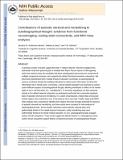| dc.contributor.author | Andrews-Hanna, Jessica R. | |
| dc.contributor.author | Yarkoni, Tal | |
| dc.contributor.author | Saxe, Rebecca R | |
| dc.date.accessioned | 2017-11-28T20:41:49Z | |
| dc.date.available | 2017-11-28T20:41:49Z | |
| dc.date.issued | 2014-01 | |
| dc.identifier.issn | 1053-8119 | |
| dc.identifier.uri | http://hdl.handle.net/1721.1/112318 | |
| dc.description.abstract | A growing number of studies suggest the brain's "default network" becomes engaged when individuals recall their personal past or simulate their future. Recent reports of heterogeneity within the network raise the possibility that these autobiographical processes comprised of multiple component processes, each supported by distinct functional-anatomic subsystems. We previously hypothesized that a medial temporal subsystem contributes to autobiographical memory and future thought by enabling individuals to retrieve prior information and bind this information into a mental scene. Conversely, a dorsal medial subsystem was proposed to support social-reflective aspects of autobiographical thought, allowing individuals to reflect on the mental states of one's self and others (i.e. "mentalizing"). To test these hypotheses, we first examined activity in the default network subsystems as participants performed two commonly employed tasks of episodic retrieval and mentalizing. In a subset of participants, relationships among task-evoked regions were examined at rest, in the absence of an overt task. Finally, large-scale fMRI meta-analyses were conducted to identify brain regions that most strongly predicted the presence of episodic retrieval and mentalizing, and these results were compared to meta-analyses of autobiographical tasks. Across studies, laboratory-based episodic retrieval tasks were preferentially linked to the medial temporal subsystem, while mentalizing tasks were preferentially linked to the dorsal medial subsystem. In turn, autobiographical tasks engaged aspects of both subsystems. These results suggest the default network is a heterogeneous brain system whose subsystems support distinct component processes of autobiographical thought. | en_US |
| dc.publisher | Elsevier | en_US |
| dc.relation.isversionof | http://dx.doi.org/10.1016/J.NEUROIMAGE.2014.01.032 | en_US |
| dc.rights | Creative Commons Attribution-NonCommercial-NoDerivs License | en_US |
| dc.rights.uri | http://creativecommons.org/licenses/by-nc-nd/4.0/ | en_US |
| dc.source | PMC | en_US |
| dc.title | Contributions of episodic retrieval and mentalizing to autobiographical thought: Evidence from functional neuroimaging, resting-state connectivity, and fMRI meta-analyses | en_US |
| dc.type | Article | en_US |
| dc.identifier.citation | Andrews-Hanna, Jessica R. et al. “Contributions of Episodic Retrieval and Mentalizing to Autobiographical Thought: Evidence from Functional Neuroimaging, Resting-State Connectivity, and fMRI Meta-Analyses.” NeuroImage 91 (May 2014): 324–335 © 2014 Elsevier Inc | en_US |
| dc.contributor.department | Massachusetts Institute of Technology. Department of Brain and Cognitive Sciences | en_US |
| dc.contributor.mitauthor | Saxe, Rebecca R | |
| dc.relation.journal | NeuroImage | en_US |
| dc.eprint.version | Author's final manuscript | en_US |
| dc.type.uri | http://purl.org/eprint/type/JournalArticle | en_US |
| eprint.status | http://purl.org/eprint/status/PeerReviewed | en_US |
| dc.date.updated | 2017-11-20T13:07:25Z | |
| dspace.orderedauthors | Andrews-Hanna, Jessica R.; Saxe, Rebecca; Yarkoni, Tal | en_US |
| dspace.embargo.terms | N | en_US |
| dc.identifier.orcid | https://orcid.org/0000-0003-2377-1791 | |
| mit.license | PUBLISHER_CC | en_US |
| mit.metadata.status | Complete | |
